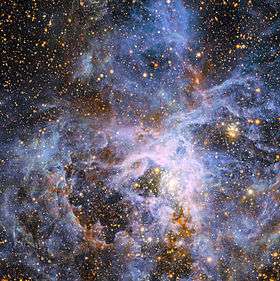VFTS 352
VFTS 352 is a contact binary star system 160,000 light-years (49,000 pc) away in the Tarantula Nebula, which is part of the Large Magellanic Cloud.[5] It is the most massive and earliest spectral type overcontact system known.[4]
 Artist's rendering of VFTS 352 binary star Credit: ESO/L. Calçada | |
| Observation data Epoch J2000 Equinox J2000 | |
|---|---|
| Constellation | Dorado |
| Right ascension | 05h 38m 28.456s[1] |
| Declination | −69° 11′ 19.18″[1] |
| Apparent magnitude (V) | 14.38[2] |
| Characteristics | |
| Evolutionary stage | Main Sequence[3] |
| Spectral type | O4.5 V(n)((fc)):z: + O5.5 V(n)((fc)):z:[3] |
| B−V color index | −0.10[2] |
| Astrometry | |
| Radial velocity (Rv) | 262.8[4] km/s |
| Distance | 164,000 ly (50,000[4] pc) |
| Orbit[4] | |
| Primary | VFTS 3521 |
| Companion | VFTS 3522 |
| Period (P) | 1.124 days |
| Semi-major axis (a) | 17.55 R☉ |
| Eccentricity (e) | 0 |
| Inclination (i) | 55.60° |
| Longitude of the node (Ω) | 3.584° |
| Semi-amplitude (K1) (primary) | 324.9 km/s |
| Semi-amplitude (K2) (secondary) | 315.6 km/s |
| Details[4] | |
| VFTS 3521 | |
| Mass | 28.63 ± 0.30 M☉ |
| Radius | 7.22 ± 0.02 R☉ |
| Luminosity | 180,000 L☉ |
| Surface gravity (log g) | 4.18 ± 0.01 cgs |
| Temperature | 42,540 ± 280 K |
| Age | 1 Myr |
| VFTS 3522 | |
| Mass | 28.85 ± 0.30 M☉ |
| Radius | 7.25 ± 0.02 R☉ |
| Luminosity | 150,000 L☉ |
| Surface gravity (log g) | 4.18 ± 0.01 cgs |
| Temperature | 41,120 ± 290 K |
| Age | 1 Myr |
| Other designations | |
| Database references | |
| SIMBAD | data |

The discovery of this O-type binary star system made use of the European Southern Observatory's Very Large Telescope,[6] and the description was published on 13 October 2015.[4] VFTS 352 is composed of two very hot (40,000 °C), bright and massive stars of equal size that orbit each other in little more than a day. The stars are so close that their atmospheres overlap.[6] Extreme stars like the two components of VFTS 352 are thought to be the main producers of elements such as oxygen.[6]
The future of VFTS 352 is uncertain, and there are two possible scenarios. If the two stars merge, a very rapidly rotating star will be produced. If it keeps spinning rapidly it might end its life in a long-duration gamma-ray burst. In a second hypothetical scenario, the components would end their lives in supernova explosions, forming a close binary black hole system, hence a potential gravitational wave source through black hole–black hole merger.[4]
See also
- Contact binary (small Solar System body), two asteroids gravitating toward each other until they touch
References
- Cutri, R. M.; Skrutskie, M. F.; Van Dyk, S.; Beichman, C. A.; Carpenter, J. M.; Chester, T.; Cambresy, L.; Evans, T.; Fowler, J.; Gizis, J.; Howard, E.; Huchra, J.; Jarrett, T.; Kopan, E. L.; Kirkpatrick, J. D.; Light, R. M.; Marsh, K. A.; McCallon, H.; Schneider, S.; Stiening, R.; Sykes, M.; Weinberg, M.; Wheaton, W. A.; Wheelock, S.; Zacarias, N. (2003). "VizieR Online Data Catalog: 2MASS All-Sky Catalog of Point Sources (Cutri+ 2003)". VizieR On-line Data Catalog: II/246. Originally Published in: 2003yCat.2246....0C. 2246. Bibcode:2003yCat.2246....0C.
- Evans, C. J.; Taylor, W. D.; Hénault-Brunet, V.; Sana, H.; De Koter, A.; et al. (June 2011). "The VLT-FLAMES Tarantula Survey. I. Introduction and observational overview". Astronomy & Astrophysics. 530: A108. arXiv:1103.5386. Bibcode:2011A&A...530A.108E. doi:10.1051/0004-6361/201116782.
- Walborn, N. R.; Sana, H.; Simón-Díaz, S.; Maíz Apellániz, J.; Taylor, W. D.; Evans, C. J.; Markova, N.; Lennon, D. J.; De Koter, A. (2014). "The VLT-FLAMES Tarantula Survey. XIV. The O-type stellar content of 30 Doradus". Astronomy & Astrophysics. 564: A40. arXiv:1402.6969. Bibcode:2014A&A...564A..40W. doi:10.1051/0004-6361/201323082.
- Almeida, L. A.; Sana, H.; Mink, S. E. de; Tramper, F.; Soszyn´Ski, I.; Langer, N.; Barbá, R. H.; Cantiello, M.; Damineli, A.; Koter, A. de; Garcia, M.; Gräfener, G.; Herrero, A.; Howarth, I.; Apellániz, J. Maíz; Norman, C.; Ramírez-Agudelo, O. H.; Vink, J. S. (2015). "Discovery of the Massive Overcontact Binary Vfts 352: Evidence for Enhanced Internal Mixing". The Astrophysical Journal. 812 (2): 102. arXiv:1509.08940. Bibcode:2015ApJ...812..102A. doi:10.1088/0004-637X/812/2/102.
- "Final Kiss of Two Stars Heading for Catastrophe". EPB. 15 October 2015. Retrieved 17 October 2015.
- "Final kiss of two stars heading for catastrophe". Astronomy Now. 21 October 2015. Retrieved 2015-10-21.